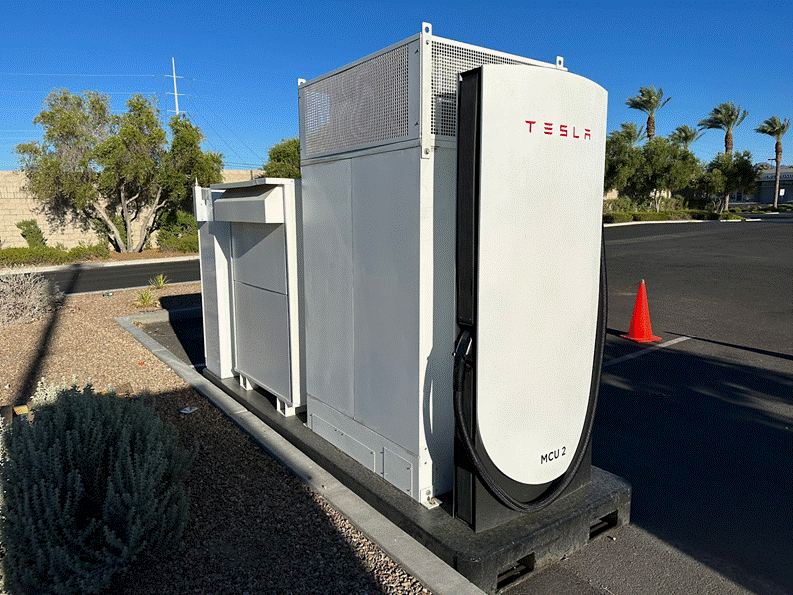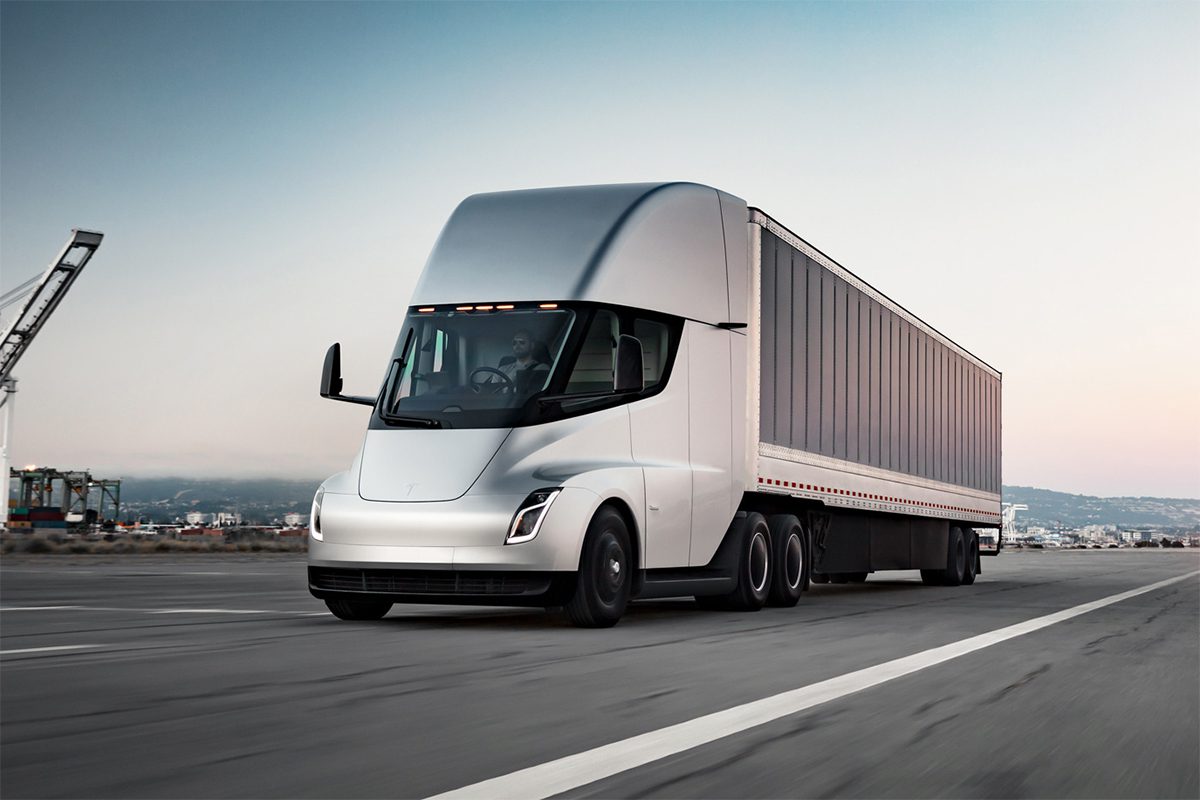The 2025 Tesla Semi 300 Mile Range represents the foundation of Tesla’s electric trucking revolution, delivering efficient regional hauling capability with exceptional operating economics at $150,000. This comprehensive guide explores the entry-level Semi variant, designed for fleet operators prioritizing maximum efficiency and cost reduction for shorter hauls and regional routes.

Tesla Semi trucks showcasing futuristic exterior design in outdoor and studio settings.
Commercial Vehicle Overview
The Tesla Semi is fundamentally different from traditional Class 8 commercial trucks, featuring revolutionary design priorities centered on driver ergonomics, efficiency, and operational cost reduction rather than raw power.
Vehicle Classification:
- Vehicle Type: Class 8 Electric Tractor (without sleeper cab)
- Configuration: Day cab with center-mounted driver position
- Gross Combined Weight Rating (GCWR): 80,000-81,000 lbs
- Maximum Payload Capacity: Approximately 20,000 lbs (depending on configuration)
- Towing Capacity: Up to 65,000 lbs (trailer + cargo)
- Overall Length: Approximately 35 feet (combined with standard 53-foot trailer)
- Curb Weight: Approximately 25,000 lbs (tractor only)
Design and Exterior
The Semi’s revolutionary aerodynamic design prioritizes efficiency, with every element engineered to reduce drag and improve performance.

Tesla Semi interior cabin showcasing the central driver’s seat and steering wheel with an overall modern design.
Exterior Specifications:
- Length: Approximately 235 inches (tractor only, ~594 mm)
- Width: Approximately 96 inches (243 mm) standard
- Height: Approximately 108 inches (2.74 m)
- Drag Coefficient: 0.36 Cd (exceptional for a Class 8 truck)
- Ground Clearance: Approximately 17-18 inches (432-457 mm)
Aerodynamic Design Elements
Integrated Bumper: Eliminates traditional stepped design, reducing drag
Tapered Cab: Smooth transitions from windshield to trailer
Underbody Panel: Covers underside to reduce turbulence
Side Mirrors: Optimized positioning and shape for minimal drag
Integrated Lighting: LED strips incorporated into body rather than protrusions
Roof Markings: Minimized, further reducing aerodynamic disruptions
The 0.36 Cd drag coefficient is exceptional for any Class 8 truck and dramatically superior to typical diesel semi trucks (0.55-0.65 Cd).
Color and Appearance
The Semi is available in several commercial finishes:
- Metallic Silver (Standard)
- Pearl White (Premium option)
- Solid Black (Premium option)
- Custom Fleet Branding (supported)
Powertrain and Performance
The 300 Mile Range Semi features a tri-motor electric powertrain optimized for efficiency and consistent performance.
Powertrain Specifications:
- Motor Configuration: 3 independent motors on rear axles (tri-motor setup)
- Total Power Output: Approximately 1,000 kW (1,340 hp combined)
- Total Torque: Approximately 11,000 Nm (8,000+ lb-ft) aggregate
- 0-60 mph: Approximately 20 seconds (fully loaded at 80,000 lbs GCWR)
- Top Speed: 65 mph (governed for safety and efficiency)
- Grade Ability: Maintains highway speed limit on 5% grades with full load
- Drive Configuration: Tri-motor rear axle with electronic torque distribution
- Wheelbase: Approximately 149 inches
The motor configuration prioritizes torque delivery and consistency over peak power, with all power engaged at startup enabling strong acceleration even with 80,000-lb loads.
Battery, Range, and Charging
Battery Specifications
Battery Type: Advanced lithium-ion liquid-cooled
Total Capacity: Approximately 900 kWh (base configuration)
Usable Capacity: Approximately 850-870 kWh
Architecture: Centralized floor-mounted battery pack
Battery Weight: Approximately 10,000-12,000 lbs (distributed under truck)
Battery Placement: Centered under frame for low center of gravity
The 900 kWh battery is approximately 10 times larger than premium passenger car batteries, providing the energy density required for Class 8 applications.
Range Specifications
300 Mile Range Configuration:
- EPA Estimated Range: 300 miles fully loaded at 80,000 lbs GCWR
- Real-World Range: 280-320 miles typical (verified by fleet testing)
- Range Variability: Dependent on payload, terrain, driving speed, and temperature
- Optimal Conditions Range: Up to 340 miles in favorable conditions
- Worst-Case Range: 240-260 miles in mountainous terrain with full load
The 300-mile range is designed for regional hauls and typical trucking routes between major distribution centers and regional hubs.
Energy Efficiency
Consumption Rate: Under 2 kWh per mile (industry-leading for Class 8)
Typical Mixed Efficiency: Approximately 1.7-1.9 kWh per mile real-world
Highway Efficiency (55-65 mph): Approximately 1.8-2.0 kWh per mile
Urban Delivery Efficiency: Approximately 1.9-2.1 kWh per mile
Real-world DHL testing confirmed approximately 1.72 kWh per mile when driving loaded Semi at highway speeds over 50 mph.
Charging Capabilities
DC Fast Charging (Megacharger):
- Maximum Power: Up to 1.2 MW (1,200 kW) on V4 Megacharger units
- 10-80% Charging Time: Approximately 30 minutes standard
- 70% Charge in 30 Minutes: Standard capability (verified by Tesla)
- 0-100% Charging: Approximately 40-45 minutes total
- Range Recovery in 30 Minutes: Approximately 210 miles for 300-mile variant
AC Charging (Depot charging):
- Maximum Power: Approximately 220 kW (on specialized chargers)
- Overnight Charging (8-10 hours): Full charge to 100%
- Standard Installation: Suitable for fleet depots and terminal locations
Charging Infrastructure
Megacharger Network Status (as of 2025):
- 46 public Megacharger stations planned by early 2027
- 300+ MW total installed capacity across network
- Located strategically on major trucking routes
- Private fleet installations already operational
- Mobile Megacharger units being deployed
Megacharger Locations (existing and planned):
- Major distribution hubs and warehouses
- Strategic highway locations for long-haul refueling
- Tesla facilities and customer terminals
- Planned expansion to cover primary trucking corridors
Interior and Operator Environment

Tesla Megacharger station with MCU 2 unit outdoors in a parking lot area.
The Semi’s revolutionary interior design prioritizes driver comfort and visibility, a departure from traditional commercial trucks.
Cabin Design and Seating
Driver Position: Center-mounted for superior visibility
- Center Seating: Elevated position provides commanding road view
- Visibility: 360-degree awareness with large windows
- Ergonomic Design: Eliminates strain from offset seating
- Accessibility: Easy entry/exit with grab handles and unobstructed steps
Interior Dimensions:
- Floor Area: Approximately 3 feet × 7 feet usable space
- Headroom: Full standing height for 6-foot drivers
- Storage: Deep door pockets, overhead compartments, rear wall storage
Seating Configuration:
- Driver Seat: Full-featured with 14-way power adjustment
- Jump Seat: Removable passenger seat mounted to rear wall (right side)
- Heating: Integrated seat heating standard
- Comfort Features: Lumbar support, reclining capability, storage beneath seat
Technology and Controls
Dual 15-inch Touchscreen Displays: Positioned on either side of driver
- Left Screen: Vehicle diagnostics, navigation, trip data, performance metrics
- Right Screen: Blind spot monitoring, backup cameras, fleet management interface
- Functionality: Real-time status, route optimization, maintenance alerts
Advanced Driver Features:
- Fleet Management Integration: Built-in connectivity for route planning and tracking
- Electronic Logging Device (ELD): Integrated compliance with federal regulations
- Blind Spot Monitoring: Real-time camera feeds on displays
- Backup Camera: Integrated into display system
- Navigation System: Tesla-developed routing considering charging infrastructure
- Climate Control: Fully electric HVAC (no diesel idle needed)
- Entertainment: Audio streaming, podcasts, navigation guidance
Climate Control:
- Electric HVAC: No engine idle required, maintaining comfort while parked
- Heated Windshield: Prevents frosting and improves winter visibility
- Seat Heating: Individual control with memory settings
- Thermal Efficiency: Heat pump technology reduces energy consumption
Storage and Practicality
Total Storage Capacity:
- Sleeper Cab Option: Available for extended-range operations
- Storage Compartments: Deep door pockets, overhead storage
- Cab-over Storage: Additional secured compartments for documents and personal items
- Under-Seat Storage: Large capacity for daily necessities
Safety Features and Fleet Management
The Semi includes comprehensive safety systems appropriate for commercial operations.
Safety Systems
- Automatic Emergency Braking: Collision avoidance with trailer detection
- Collision Warning: Forward-facing alerts for vehicles ahead
- Lane Keeping Assist: Corrective steering to maintain lane position
- Blind Spot Monitoring: Real-time visual alerts on displays
- Backup Camera: Integrated system with predictive path line
- Trailer Monitoring: Real-time trailer status and diagnostics
- Stability Control: Electronic traction control optimized for heavy loads
Fleet Management Integration
- Real-Time Tracking: GPS location and route verification
- Performance Monitoring: Engine efficiency, braking patterns, acceleration data
- Maintenance Alerts: Predictive maintenance scheduling
- Driver Scoring: Safety metrics and performance analytics
- Route Optimization: Charging infrastructure integrated into navigation
- Over-the-Air Updates: Remote software and feature deployment
Warranty and Service
Tesla provides comprehensive commercial fleet support:
Vehicle Warranty
- Basic Warranty: 4 years or 100,000 miles
- Battery Warranty: 8 years or 500,000 miles
- Powertrain Warranty: 8 years or 500,000 miles
- Coverage: Manufacturing defects, components, workmanship
Fleet Service Support
- Mobile Service Units: Traveling technicians for fleet locations
- 24/7 Support: Emergency roadside assistance
- Predictive Maintenance: Scheduled service based on usage patterns
- Parts Availability: Growing network of authorized service centers
Operating Costs and Economics
Fuel/Electricity Costs
Energy Consumption Calculation:
- Consumption Rate: Under 2 kWh per mile (average 1.85 kWh/mile)
- Electricity Cost: Approximately $0.14-$0.28 per mile (varies by region)
- Diesel Equivalent: Approximately $0.60-$0.85 per mile for diesel truck
- Annual Savings (125,000 miles): Approximately $50,000-$85,000
Real-World Comparison:
- Diesel Semi: $0.60-$0.85 per mile for fuel
- Tesla Semi 300: $0.14-$0.28 per mile for electricity
- Fuel Cost Savings: 50-67% reduction vs. diesel equivalents
Maintenance Costs
Reduced Maintenance Requirements:
- No Oil Changes: Required
- No Transmission Service: Needed
- No Spark Plugs: To replace
- Brake Maintenance: Significantly reduced due to regenerative braking
- Annual Maintenance: Estimated $3,000-$5,000 vs. $8,000-$12,000 for diesel
Total Cost of Ownership (10-Year Analysis)
Capital and Operating Costs:
- Vehicle Cost: $150,000
- Federal Tax Credit: -$40,000 (estimated)
- Effective Purchase Price: $110,000
10-Year Operating Costs:
- Electricity (1.25 million miles): $185,000-$350,000
- Maintenance: $35,000-$50,000
- Registration/Licensing: $10,000-$15,000
- Tire Replacement: $25,000-$35,000
- Total 10-Year Cost: $365,000-$460,000
Comparable Diesel Semi 10-Year Cost:
- Vehicle Cost: $150,000
- Diesel Fuel (1.25 million miles): $750,000-$1,062,500
- Maintenance: $100,000-$150,000
- Registration/Licensing: $10,000-$15,000
- Tire Replacement: $30,000-$40,000
- Total 10-Year Cost: $1,040,000-$1,357,500
Total 10-Year Savings: $675,000-$897,500 vs. comparable diesel semi
Fleet Performance Data
Real-world Tesla Semi operations have provided concrete performance metrics:
Operational Uptime
- 95%+ Uptime: Including all scheduled and unscheduled maintenance
- Comparable Diesel: 90-95% uptime when properly maintained
- Reliability Advantage: Fewer moving parts, simpler systems
Real-World Fleet Testing Results
DHL 3,000-Mile Trial (2024):
- 390-mile fully loaded haul (75,000 lbs GCWR)
- Average efficiency: 1.72 kWh per mile
- Performance exceeded expectations and Tesla specifications
- Confirmed ability to haul “typical DHL payloads over long distances”
Individual Semi Performance (18-month deployment):
- 248,000 miles accumulated
- Maintained performance and reliability
- Demonstrated long-term viability for fleet operations
Daily Route Performance:
- Average daily mileage: 794 miles
- Range achieved: 227-377 miles per charge
- Multiple charging stops manageable within typical operations
Who Should Buy the Tesla Semi 300 Mile Range?
The Tesla Semi 300 Mile Range is ideal for:
Regional Trucking Operations with regular routes within 300-mile segments
Fleet Operators prioritizing cost reduction and operational efficiency
High-Volume Short-Haul Fleets (distribution centers to regional hubs)
Environmentally Conscious Operators committed to zero-emission transportation
Early Adopters comfortable with evolving charging infrastructure
Cost-Conscious Fleet Managers focused on total cost of ownership reduction
Urban and Regional Delivery operations with predictable daily routes
Final Verdict
The 2025 Tesla Semi 300 Mile Range is a revolutionary commercial truck delivering 300-mile range, exceptional efficiency (under 2 kWh per mile), and transformative operating economics at $150,000. The tri-motor powertrain provides consistent torque delivery for 80,000-lb loads, while the center-mounted driver position and dual touchscreen displays optimize the operator environment.
Real-world fleet testing confirms 280-320 mile range under typical operating conditions. The estimated $50,000-$85,000 annual fuel cost savings vs. diesel equivalents creates 2-3 year payback periods for fleet operators.
For regional trucking operations prioritizing efficiency, cost reduction, and environmental responsibility, the Tesla Semi 300 Mile Range represents the future of commercial transportation—proof that electric vehicles can meet or exceed the operational requirements of professional trucking while dramatically reducing both operating costs and environmental impact.

